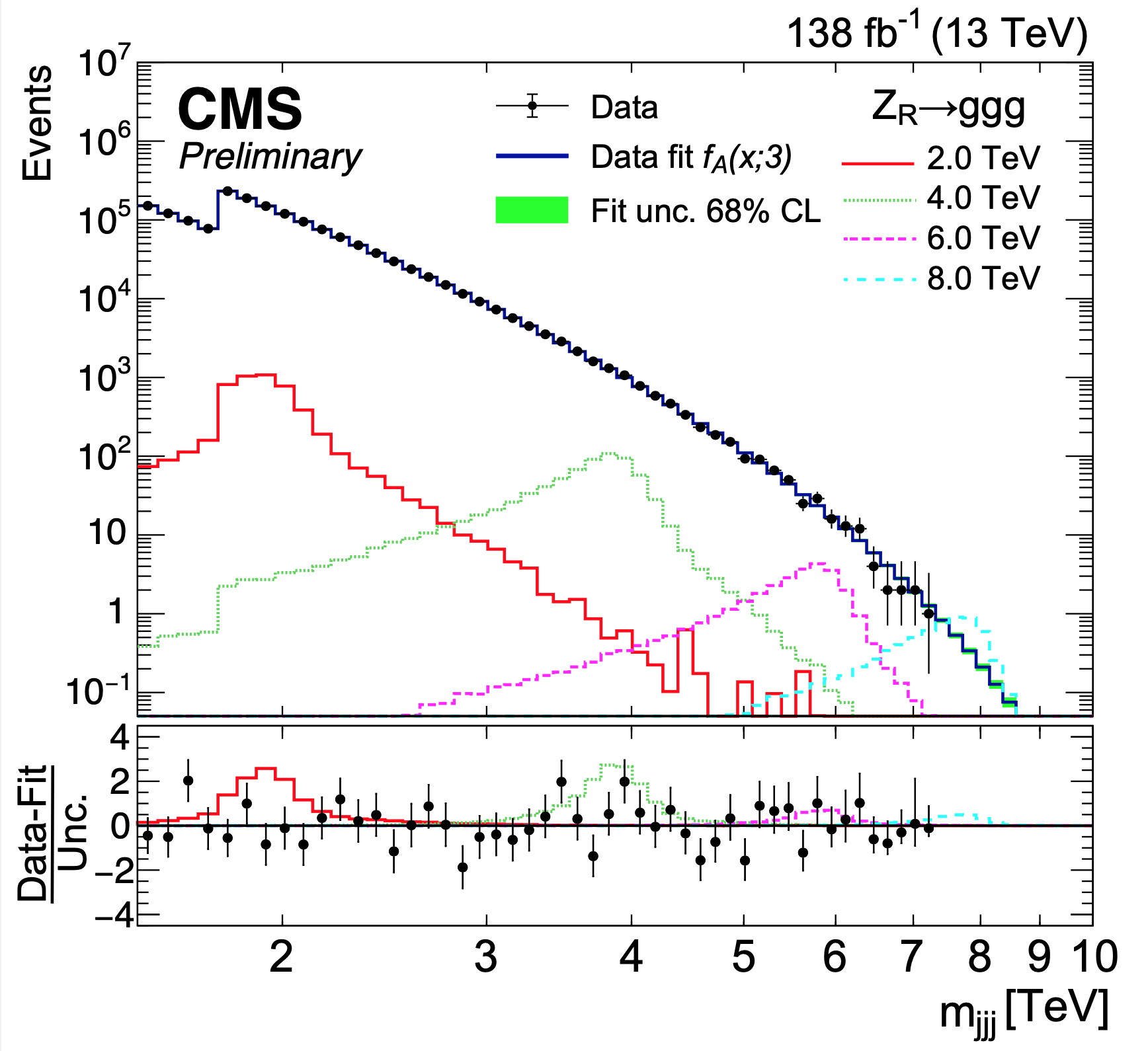
Three-jet event with an invariant mass of 7.2 TeV, showing the jets (yellow cones) and the energy deposited in the electromagnetic (green) and hadron (blue) calorimeters.
With the discovery of the Higgs boson, the Standard Model of particle physics (SM) was confirmed as the most elegant and successful theory we have to describe the universe. Still, several open questions remain, such as the matter-antimatter asymmetry or the existence of dark matter. Potential solutions to these puzzles indicate new physics at the TeV energy scale, so that efforts have been invested in searches for new particles with masses larger than around 1 TeV. Such particles are predicted in several beyond-the-SM theories (BSM): Z’ models, compositeness models, extra-dimensional models, etc. The CERN LHC accelerator offers the best chance to produce such particles and we might be able to detect them through their decays into quarks and gluons, which hadronize into particles emitted in a narrow cone, seen in the detectors as collimated jets.
The CMS Collaboration has just reported the first-ever search for the single production of new heavy particles that decay directly, or via intermediate particles, into three well-resolved jets, exhibiting a distinctive three-prong topology (“the three-pointed star”). The considered processes are illustrated by the schematic diagrams shown in Fig. 1. To distinguish potential signal events from numerous background events, where three random jets were produced from SM processes, various selection criteria are employed using information concerning the geometrical separation between the three jets. The invariant mass of the three-jet system is computed and its distribution is scrutinized to search for peaks that might appear above the smooth SM background continuum. Seeing such “excesses” would be compelling evidence for the existence of BSM physics.

Figure 1: Feynman diagrams illustrating the production of an hypothetical BSM particle (in blue) that decays into three jets: a right-handed Z boson that decays to three gluons (left); a Kaluza-Klein gluon that decays to three gluons via an intermediate spin-0 particle (center); and an excited quark that decays to three quarks via an intermediate vector boson (right).

Figure 2: The measured three-jet invariant mass distribution (black dots) and the background-only fit result (blue histogram). Hypothetical signals from right-handed Z bosons of four different masses are also shown. The bottom panel shows the difference between the data and the fitted background, divided by the total uncertainty, showing no significant excesses.
After a careful analysis of the data collected from 2016 to 2018, the CMS physicists saw no statistically significant excesses, as shown in Fig. 2. This implies that the frequency for such a new particle to be created by the proton-proton collisions should be smaller than certain values, which physicists call “upper limits”. These are the first constraints on the existence of such new heavy particles decaying into three resolved jets, providing valuable guidance for further theoretical and experimental endeavors.
The LHC resumed data taking in 2022 with a higher center-of-mass energy, 13.6 TeV. Nearly 40 times more data are expected to be collected with the planned High-Luminosity LHC upgrade in the next two decades. The higher collision energy and the substantial increase in data volume, as well as the development of new data analysis methods involving advanced machine learning techniques, will further enhance our sensitivity to the signal, leading to more stringent limits or, ideally, to the discovery of new particles that decay into three jets with a three-pointed star topology!
You can open the interactive event display on this separate page.
Read more about these results:
-
CMS Physics Analysis Summary "Search for narrow trijet resonances in proton-proton collisions at √s =13 TeV"
-
@CMSExperiment on social media: LinkedIn - facebook - twitter - instagram
- Do you like these briefings and want to get an email notification when there is a new one? Subscribe here

